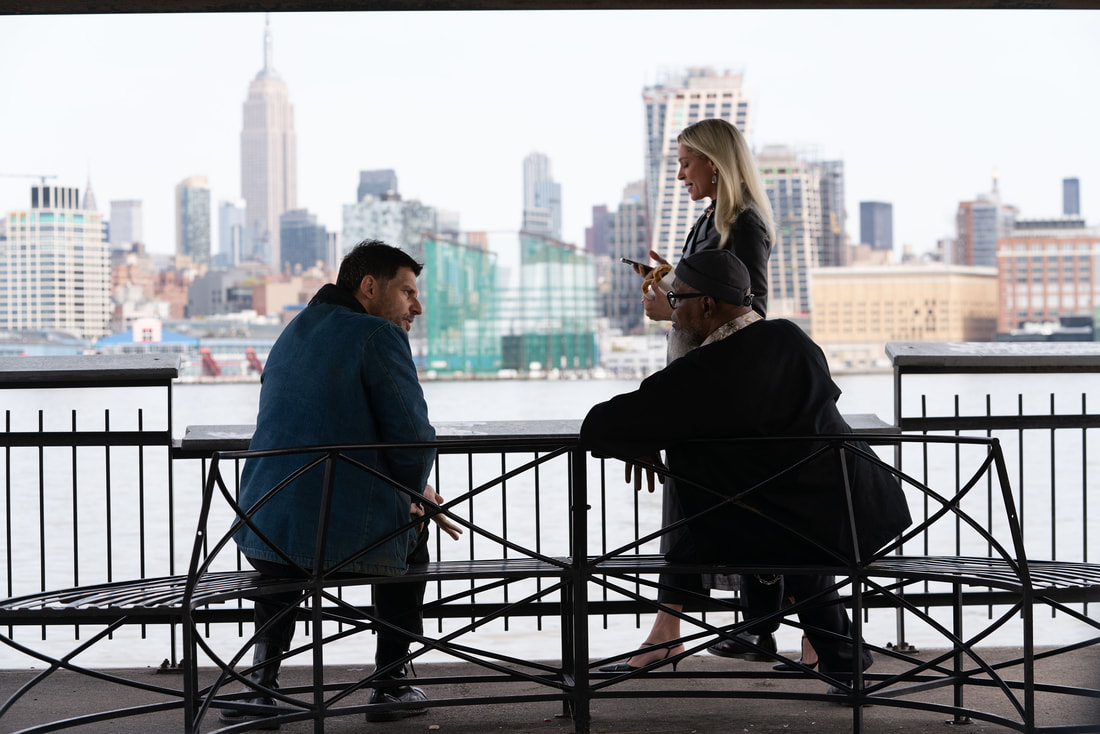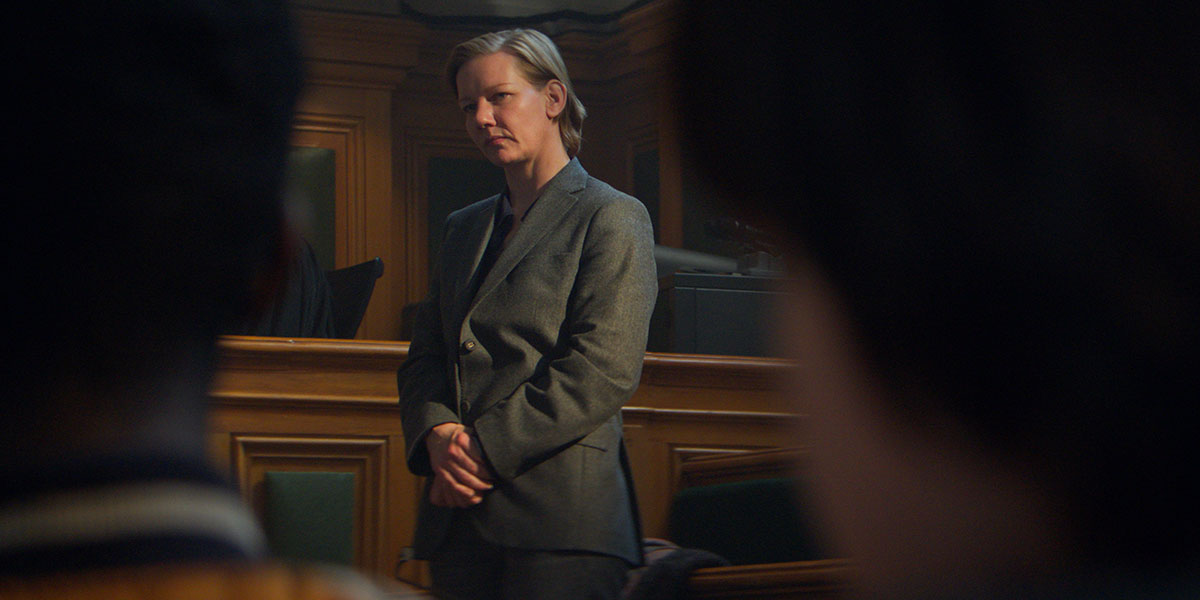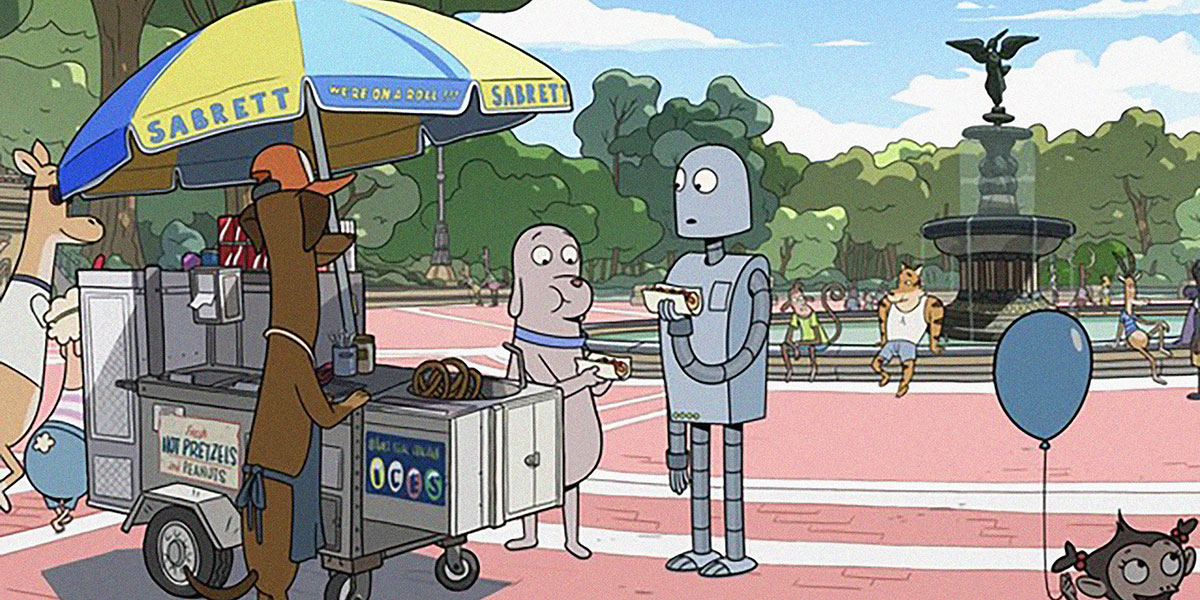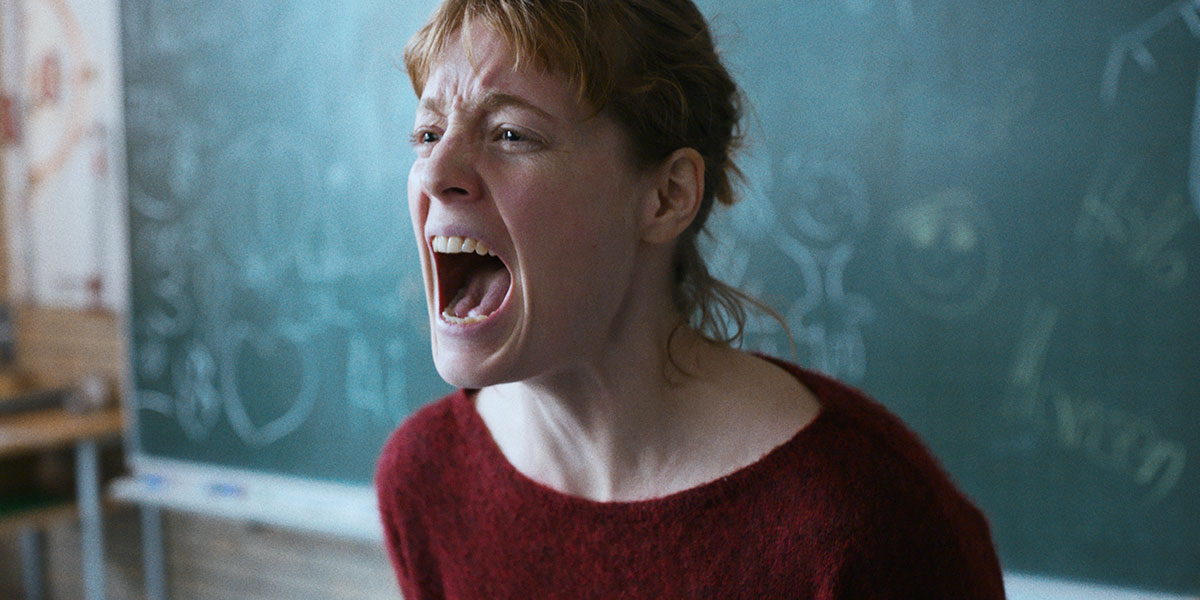|
Reviewed by Jonathan Berk A good crime comedy can leave you feeling a little dirty, but oddly satisfied. It takes a certain temperament to laugh at the dark humor inherent in the genre. Sensible people often know they probably shouldn’t laugh at those moments, but the absurdity of the way they are presented coax the laughs out almost uncontrollably. Fans of the Coens’ films like Burn After Reading, The Big Lebowski, and the Oscar-winning Fargo will see glimmers of those films in director Nicol Paone’s new film The Kill Room. While it never gets to the level of those Coen films, there is enough of that DNA in it that fans will find something to enjoy. Uma Thurman plays Patrice, an owner of an art gallery that isn’t making much money. Samuel L. Jackson plays Gordon Davis, an owner of a Jewish bakery, though that’s a front he uses for organizing hits for the mob with his partner Reggie a.k.a "The Bag Man” (Joe Manganiello), who needs a new way to launder their dirty money. Patrice is introduced to Gordon via her drug dealer (Matthew Maher). An arrangement is made where Reggie will make “art” and Patrice will sell it, giving them all a nice cut of the sale. However, when Reggie’s first piece sells for a notable price, it sets the art world abuzz, drawing unwanted attention to the hitman and his underworld buyers. Thurman, Jackson, and Manganiello are definitely having a lot of fun making this movie. Their chemistry and performances make the film much more fun than it would have been otherwise. Thurman’s character especially feels underwritten at times, and the emotional stakes of her character aren’t as developed as they need to be to get the audience fully invested, but her performance helps fill in the gaps in the writing. Manganiello's character opens the film with a somewhat cliche shot of a plastic bag floating in the wind, a la American Beauty, before showing one stuck on a storm grate he walks past. The camera tracks him as he enters a bodega. He demands a refund for bad coffee and an argument with the clerk, but it’s really just a rouse to find out if there is a security camera or not. This leads to the first kill we see, featuring a plastic bag paying off that opening cliche unexpectedly. The scene is a solid primer for what the film will be, as the scuff marks left by the first victim's shoes cross-fades into a piece of art on display at Patrice’s gallery. Audiences should know immediately if they’re on board for this particular ride.
The weakness of the film seems to mostly stem from the script. Apart from the characters not getting enough development, there are too many things going on that the film tries to juggle. Just in Patrice’s story, there are many players the film has to give time to, including her rival art gallery and its owner, the various collectors who now want a piece of the Bag Man, the art critic played by Debi Mazar, and her assistant (Amy Keum), all of whom have to be introduced and their roles in the plot explained. The underworld side has the mob bosses, and the backstory of Reggie worked into the film. It’s quite a complex story, and it's in these complexities that writers like the Coens find so much of the humor. It happens in this film, but not as expertly done. Despite that, The Kill Room was a perfectly enjoyable time at the movies, assuming you find dark humor entertaining. Paone’s second feature film shows a lot of promise, and the cast seemed to have had a blast based on their screen presence. It’s possible that we all just need to find that inner artist to help express ourselves to escape the joyless job in which we are currently trapped. The Kill Room is in theaters on September 29. Rating: 3.5/5
0 Comments
[Fantastic Fest 2023] SO UNREAL -- Amanda Kramer's Documentary is Expectedly Bizarre, Trippy9/25/2023
Review by Sean Boelman
Amanda Kramer is no stranger to Fantastic Fest, her previous features Give Me Pity! and Ladyworld both having played at the Austin genre festival. So Unreal is Kramer’s first foray into documentary filmmaking, and it’s just as idiosyncratic as one would expect — an intriguing experiment in formalism that is full of interesting ideas, even if they don’t always pay off.
In the movie, Kramer explores the genre of cyber-cinema, considering the role of classics (The Matrix, The Terminator), cult classics (eXistenZ, Tetsuo: The Iron Man), and even more obscure films in a discussion of the relationship between technology, the media, and ourselves. Like many essay films, So Unreal is likely a cinephiles-only affair, but it is made even more so by a challenging structure that threatens to test the viewer’s patience. Kramer’s documentary is one of transformation — future into present, utopia into dystopia, dream into reality, and literal into abstract. What starts as an examination of cyber-cinema soon evolves into something attempting to be more profound: an exploration of what makes us human. Although Kramer doesn’t always succeed in philosophizing on this theme in depth, she should at least be given credit for making such an ambitious swing. The film takes some tangents that are intriguing, but aren’t explored substantially enough to really challenge the viewer. For example, there is a section that addresses the inherent sexuality of some of the cyber-cinema films used as case studies, which is a natural extension of Kramer’s filmography, but there’s enough content here to make a documentary in and of itself — not just one section of a larger documentary.
Ultimately, this is an essay film that is less about its content than it is about the vibes. Of course, as much of the movie’s success in that regard is owed to editor Benjamin Shearn and composer Josh Ascalon (who also share the credit for sound design) as it is to Kramer. So Unreal fittingly has an entrancing nature to it thanks to the hypnotic soundscape by Shearn and Ascalon.
The tone is further set by a narration track by Debbie Harry, the frontwoman of the classic rock band Blondie. There doesn’t seem to be a whole lot of rhyme or reason to why Harry was chosen for the role other than her voice having the perfect blend of serenity and sensuality to make the film feel more alluring. To tell this story, Kramer uses a combination of 16-bit-esque graphics from Jon Cooper and footage from the movies she is referencing. It’s definitely a lot more kinetic than your average video essay thanks to the retrofuturist vibe to which Kramer is fully committed, effectively creating the ethereal vibe that is clearly the intention. So Unreal is certainly an ambitious documentary, and it deserves a great deal of recognition for that alone. However, in its ninety-odd minute runtime, it arguably attempts to bite off more than it can chew, leaving its thematic exploration feeling somewhat underwhelming and making it more effective as a sensory experience. So Unreal is screening at the 2023 Fantastic Fest, which runs September 21-28 in Austin, Texas. Rating: 3/5
Review by Sean Boelman
Some films are so ambitious that you could never imagine their lofty swings paying off, and yet they do. Masterfully blending sci-fi, horror, and romance, The Beast is a dense movie that lends itself to analysis and dissection over multiple watches, but it’s an experience you will not soon forget.
The film follows a woman who decides to have an operation to have her DNA — and memories of her past lives — erased, finding that her fate might be inexplicably intertwined with that of a man she finds eerily familiar. Taking inspiration from a 1903 short story called “The Beast in the Jungle,” the movie is best described as if David Cronenberg had directed Eternal Sunshine of the Spotless Mind. One of the most challenging things about the film is its intricate narrative structure that unfolds like a puzzle. With storylines set in 1904, 2014, and the future, The Beast weaves together these different permutations of the tragic love story to create an evocative dive into the ideas of memory and love. The movie is extremely dense in a way that demands multiple watches to fully grasp everything it is trying to say. The central theme of love radiates throughout the film, but in a way that is nothing short of unorthodox. However, there are some other interesting themes that Bonello and his co-writers play around with, including the toxicity of online culture, that feel extraordinarily modern and zeitgeisty. Also intricate is the character development, which goes beyond the standard archetypes you would expect from a star-crossed lovers storyline. Particularly when it comes to the male love interest, the movie challenges the viewer’s expectations of what we are supposed to think about love interests. The film is buoyed by what are two of the best performances of the year from George MacKay and Léa Seydoux. While Seydoux is just excellent at doing her own thing, MacKay’s performance is incredible, as he effectively plays three different characters in one. And the chemistry between the two of them — across all three timelines — sparks in a way that few other on-screen couples ever have. The narrative ambition of The Beast is only matched by Bonello’s visual ambition. The timeline set in 1904 would be impressive enough on its own as a period piece with some fantastic production design. However, when you add in the futuristic storyline and the horror-tinged 2014 storyline, you have what might be one of the most visually eclectic and distinct movies of the year. While some viewers will understandably be put off by the complex nature of The Beast’s narrative, it’s one of the most profound films you will see this year. A pinnacle of filmmaking in all of its genres, The Beast is the type of movie that will undoubtedly make a splash among cinephiles, even if it has little to no chance of being a mainstream breakout. The Beast screened at the 2023 Toronto International Film Festival, which ran September 7-17 in Toronto, Canada. Rating: 5/5
Review by Sean Boelman
Anatomy of a Fall won the Palme d’Or upon its debut at Cannes, and is now making its way through the festival circuit before a hopeful awards run in the fall. Justine Triet’s film might not be as weighty as you expected it to be, but it's a completely gripping watch thanks to flawless execution.
The movie follows a woman who is accused as the sole suspect in the case of her husband’s suspicious death. It’s a film that unfolds in a constantly surprising way, even if we think we know where it is heading, as the script forces us to think back on what we remember and challenge the idea of trust. What is most surprising about Anatomy of a Fall is that it is thoroughly entertaining. Despite a two and a half hour runtime, a substantial portion of which takes place in a courtroom, it manages to be utterly captivating. The dialogue by Triet and Arthur Harari is very sharp and rapidly paced, keeping the movie engaging even when it falls into more familiar territory. That being said, the film is unexpectedly shallow and straightforward. Although there are some undercurrents that viewers could read into — like the misogyny of the justice system assuming it’s the wife who did it, as well as a few others that are best not discussed to let the twists of the case unfold naturally — it’s really a pretty standard courtroom drama, just extremely well told.
Anatomy of a Fall also fumbles some of its characterization. Although the protagonist is naturally compelling, and the movie does an excellent job of planting the right seeds of doubt in the mind of the viewer, the supporting characters are a tad underwhelming. For example, the film attempts to do something complex with her son, but it results in a decision that could have many viewers turn on him rather than sympathize with him.
Still, the excellent ensemble makes the most out of the characters, adding a much-needed level of nuance. Sandra Hüller’s performance will go down as one of the best of the year. Not only is it impressive how much emotion she is consistently able to get out of the role despite it being trilingual, but it’s a turn that feels extremely subdued — even in the moments of more heightened emotion. In the supporting cast, Milo Machado Graner, Samuel Theis, and Swann Arlaud all do an excellent job as well. The movie is also brilliantly executed. The cinematography by Simon Beaufils is perfect, with a feeling of coldness and clinicality that is necessary for the tone to be effective. The sound design is also excellent, with some recurring motifs — including a steel drum cover of “PIMP” being used to especially unnerving effect. Anatomy of a Fall is an unexpectedly unfussy, unpretentious film. Instead, it’s entertaining in a way that unfolds as a nail-biting thriller as opposed to your standard courtroom drama. It’s the rare Palme d’Or winner that seems to have genuine mainstream breakout potential, as it’s just that captivating. Anatomy of a Fall screened at the 2023 Toronto International Film Festival, which ran September 7-17 in Toronto, Canada. Rating: 4/5
Review by Sean Boelman
Robot Dreams is a Spanish-French co-production based on an American graphic novel and featuring no dialogue. However, the story and message are so universal that it transcends all of these borders. Robot Dreams is truly a highlight in the animated cinema canon of 2023, featuring a story that’s so downright adorable it would be impossible to hate.
Based on the graphic novel by Sara Varon, Robot Dreams follows an anthropomorphic dog who purchases a robot to be his best friend, only for them to be separated, sending them on a quest to be reunited with one another. Viewers will run the gamut of emotions watching this — you’ll laugh, you’ll cry, and you’ll go “awwww” several times — but that’s exactly the way it should be. The choice to tell the film’s story with no dialogue and purely visual storytelling was an ambitious decision for director Pablo Berger, but it pays off quite well. The sound design of the movie is excellent, managing to get so much emotion out of something as simple as a squeak or the recurring motif of Earth, Wind & Fire’s “September” (which you may never hear without crying ever again after seeing this movie). Yet, despite the fact that they never utter a word, it’s easy to fall in love with Dog and Robot. The amount of characterization Berger is able to get out of the characters early on through their actions and mannerisms will connect you with them immediately — although it would be hard not to love a dog and a robot being best friends anyway. As one would expect, there are some moments in the film that are a bit tear-jerking. However, the movie culminates in one of the most emotional finales you’ll see in any animated movie this year, and every bit of the emotion you will feel is earned. It’s not the type of contrived ending that feels like it exists just to make viewers cry, but instead, is just incredibly poignant. The 2D animation of Robot Dreams is also quite strong, chosen to replicate the style of Varon’s graphic novel. It’s very playful and lighthearted, yet done with an extraordinary amount of artistry — especially with regards to the backgrounds of this alternate version of New York City and the emotive character designs. As the film was adapted from a graphic novel, it does have a bit of an episodic structure, much as one sees the stories confined within panels and pages of the source material. At a certain point, it begins to feel like you’re traveling along with Dog and Robot on a series of little adventures, giving it an absolutely magical feeling. Robot Dreams is not just an adorable and poignant animated movie, but it’s an extraordinary achievement in visual storytelling. The fact that Berger was able to get so much emotion out of a simple premise with no dialogue is absolutely astounding, making this an early contender for best animated film of the year. Robot Dreams screened at the 2023 Toronto International Film Festival, which ran September 7-17 in Toronto, Canada. Rating: 5/5 [TIFF 2023] THE TEACHERS' LOUNGE -- Gripping German Drama Has Small Scale, but Believable Stakes9/24/2023
Review by Sean Boelman
The Teachers’ Lounge debuted at the 2023 Berlin International Film Festival to strong reviews and has since earned Germany’s submission for the Best International Film Oscar. Although the film might seem quaint by its premise, director Ilker Çatak has managed to make something unexpected out of it.
The movie shows the impact that reverberates throughout a school when a teacher accuses one of her colleagues of theft. While the story is certainly very intimate and small in scale, expert direction from Çatak will keep the viewer consistently engaged and reaffirms viewers of the intense stakes. Without a doubt, the best part of the film is its pacing, which will keep viewers on the edge of their seats for the entirety of the ninety-odd-minute runtime. Although the movie is not exactly a thriller, the story unfolds in a way that you could almost mistake it for one, concluding in an explosive final act at once feels frustrating and like the natural conclusion to this story. It’s interesting to see that — in a year with so many films set in the educational system dealing with timely themes — Çatak and Johannes Duncker’s script deals with something much more timeless. Although there are some uniquely 21st century themes on display here (unauthorized recording being the most prominent), the movie is less focused on the setting than the connections that bind its characters. Çatak and Duncker do an extraordinary job of giving us characters that are tremendously nuanced. The decisions made by the characters are often frustrating, but the film deals in the empathetic humanity of their actions. Even more interesting is the fact that the audience is not asked to pick a side, instead being shown the tragic aftermath for all parties. Leonie Benesch’s performance in the lead role is utterly gripping. She plays the character with a level of restraint, yet also a palpable anger, imbuing it with a sense of verisimilitude that is essential for the movie to have its emotional impact. Also impressive is young actor Leonard Settnisch, who gives a quiet but often powerful turn. Çatak has exquisite control over the film from a directorial standpoint, working with his collaborators to create a consistently unnerving atmosphere. Judith Kaufmann’s camera is wonderfully fluid, often making the viewer feel claustrophobia through prolonged close-ups. And Marvin Miller’s score does a great job of heightening the viewer’s suspense. The Teachers’ Lounge is an unexpectedly great movie, taking its somewhat simple premise and making an absolutely captivating film out of it. From great performances to strong direction, it’s truly engrossing and unexpected. If this does not end up in the slate of nominees for the International Film Oscar, the Academy will have made a massive mistake. The Teachers’ Lounge screened at the 2023 Toronto International Film Festival, which ran September 7-17 in Toronto, Canada. Rating: 5/5
Review by Sean Boelman
Richard Linklater’s latest film Hit Man debuted earlier this month at the Venice Film Festival to raves, and while it’s enjoyable enough, it feels rather slight. A crowd-pleaser that never challenges the audience in any way, the movie lacks much of an identity beyond vague quirkiness.
The film follows a professor who, on the side, works with the CIA to pose as a hit man, capturing those who hope to order a murder. It’s an interesting concept (partially inspired by a true story) that one would hope Linklater would use in a Bernie-esque dark comedy way. Unfortunately, Hit Man is a bit too candy-coated for its own good. What is surprising about the movie is that, for most of its runtime, it’s a relatively standard romantic comedy. It shares much more in common with School of Rock or Where’d You Go, Bernadette than Before Midnight or Boyhood. That’s not to say Linklater isn’t also good at directing comedy, but this one lacks the spark it needed to fully work. That being said, in the final act of the film — with one expertly sharp scene kicking it off in particular — it finally channels the energy that viewers will have been hoping for from the beginning. Had the movie been able to achieve and keep this momentum early on, it would have been one of the most charming movies of the year.
The film is certainly made better by an extraordinary performance from Glenn Powell, who previously worked with Linklater as one of the members of the ensemble in Everybody Wants Some!! He exudes an effortless charm in the role, finding the right balance between confidence and lovable goofiness.
Looking at the supporting cast, everyone pales in comparison to Powell. Adria Arjona has decent chemistry with the leading man, but otherwise isn’t able to hold her own against the more charismatic performer. Retta gets a few funny moments as the sidekick to Powell’s agent, but is just there to get the laugh. Visually, the movie is surprisingly not as good as one would hope. Obviously, it’s competent considering Linklater’s experience, but it’s disappointingly vanilla as Linklater adheres to the typical style of the romantic comedy genre. The only thing about the film that feels stylistically inspired are some of the needle drops, which give it a nice tone. Hit Man is an amusing little movie, but its appeal stops there. Apart from a strong performance by Glenn Powell, there’s really nothing about this film that’s overly special above your average romantic comedy with a unique premise, and that’s disappointing considering the talent involved. Hit Man screened at the 2023 Toronto International Film Festival, which ran September 7-17 in Toronto, Canada. Rating: 3/5 [TIFF 2023] HOW TO HAVE SEX -- Molly Manning Walker Makes a Stirring, Visually Impressive Debut9/24/2023
Review by Sean Boelman
Molly Manning Walker’s feature debut How to Have Sex debuted in the Un Certain Regard section at this year’s Cannes, where it walked home with the top prize in the category. Although the film definitely works best on an aesthetic level, it's hard to discount the subtle character work that Walker offers in her debut, resulting in an unexpectedly emotional experience.
The movie follows a group of three teenage girls who go on a summer vacation, with the goal of partying and hooking up with attractive boys. Although this core premise is one that has been done by dozens of films before — if not more — How to Have Sex approaches it in such an unfussy, incredibly naturalistic way that it still feels refreshing. This is the type of movie that deals more in vibes than narratives. Although there is a story, which becomes particularly prominent in the third act, it’s better to let the movie wash over you as an experience, rather than try to cling to the narrative threads it contains. Then, the more emotional final act will be able to resonate even more. Like so many coming-of-age movies, How to Have Sex deals with the concept of what it means to grow up. However, while many films in the genre explore how people are forced to grow up, Manning Walker’s debut stands out in that its protagonist is pushing herself to grow up prematurely, allowing the movie to ask refreshing questions that are uncommon to the genre. A big part of what makes the film work so well is the verisimilitude with which they approach the characters. Around every corner, they are making stupid decisions — as teenagers often do — but it will be endearing to viewers as they remember the times when they made those decisions in their own youth. Mia McKenna-Bruce is fantastic in her leading role, bringing to the character a perfect dichotomy of both sadness and hope. Her chemistry with the other two actresses who play her friends — Lara Peake and Enva Lewis — is also fantastic. In the supporting cast, Shaun Thomas shines as the love interest, with a certainly charming presence but also a subtly mysterious undercurrent running through his performance. The movie absolutely thrives in its execution, with fantastic cinematography and a great soundtrack that fully immerses you in this rave culture. It should come as no surprise that Manning Walker’s background is as a cinematographer, as her eye for aesthetics in her debut is absolutely astounding. How to Have Sex offers some of the best vibes you’ll see this year until a third act that brings everything the film is exploring together in an absolutely soul-crushing way. Molly Manning Walker’s debut is one of the finest of the year, and cements her as a voice to watch out for in the future. How to Have Sex screened at the 2023 Toronto International Film Festival, which ran September 7-17 in Toronto, Canada. Rating: 4.5/5
Review by Sean Boelman
Riddle of Fire debuted in the Directors’ Fortnight sidebar at Cannes earlier this year to a positive, but relatively low-key reception. Now, it is reappearing where it belongs — at genre festivals, starting with a slot in TIFF’s Midnight Madness program. This throwback is both adorable and fun, cashing in on nostalgia without ever feeling like nostalgia bait.
The film follows a group of three children who find themselves on an adventure up against a mysterious coven after they are sent by their mother on a quest to procure her favorite blueberry pie. It’s a magical adventure that reminds you of the likes of The Goonies or Stand by Me, with light supernatural elements, but really just an innate love of the innocent joy of childhood. Part of what makes Riddle of Fire work so well, especially in comparison to other pieces of retro/throwback media, is that it truly understands what made the media it references work beyond a superficial level. There’s a very tongue-in-cheek nature to everything happening here — the MacGuffin is a blueberry pie, after all — which gives the movie its much-needed feeling of innocent fun. That’s not to say that the film doesn’t also nail the aesthetic, because it absolutely does. Although there are some undeniably modern elements — like the object of the opening heist being a “cutting-edge” video game system — the cinematography by Jake Mitchell, shot on 16mm Kodak film, lends it a grainy aesthetic that offers the perfect level of nostalgia.
However, in feeling like it was ripped out of the ‘80s, Razooli’s movie does also have the somewhat meandering pacing of the children’s films of the era. It’s more about capturing the sense of childlike wonder that comes with the adventure than the destination the characters reach, and if you are willing to meet the movie on that wavelength, you will be engrossed.
The film will live or die based on how connected the viewer is able to become to the central characters, and thankfully, Razooli writes them in a way that’s almost impossible not to love. Although they do have the archetypes of the genre at their core, they defy expectations throughout the movie in a way that makes them feel endearing and unique. Razooli deserves praise for getting what might be three of the finest child performances in recent memory. Charlie Stover, Phoebe Ferro, and Skyler Peters are all fantastic in their roles. Not only are they adorable, but also surprisingly nuanced and emotional, especially given the somewhat absurd nature of their actions on display. Riddle of Fire is the rare homage that actually manages to stand up to the media it references, capturing the atmosphere perfectly while also offering a fun adventure of its own. Weston Razooli’s directorial debut is just so fun that it will be exciting to see what he does next. Riddle of Fire screened at the 2023 Toronto International Film Festival, which ran September 7-17 in Toronto, Canada. Rating: 4/5
Review by Sean Boelman
When Wim Wender’s Perfect Days was announced as the Japanese submission for the Best International Film Oscar, a number of master Japanese filmmakers were left in the dust, including Hayao Miyazaki, Ryusuke Hamaguchi, and Hirokazu Kore-eda. Kore-eda’s latest, Monster, definitely feels different from his usual work for a multitude of reasons, but it’s still a strong and intriguing movie with nuanced direction.
Monster follows a school-age child who becomes embroiled in a complex dilemma when he starts behaving strangely, causing his mother to investigate his teacher whom she believes to be the cause of his behavior. Interestingly, Monster is Kore-eda’s first movie not written by himself, and Yûji Sakamoto’s script is the source of most of the film’s weaknesses. The movie has a Rashomon structure, where we see the events of the film unfold from three different perspectives, adding more to the story with each permutation. Although this is clearly done with the intent of showing that no one person knows the full truth, it does undermine the pacing and suspense at a few points. Sakamoto’s character development is very unsatisfying for much of the first two-thirds, taking until the final third to tie everything together. As such, viewers might spend much of the runtime feeling disillusioned with the characters’ actions until the pieces fall into place. It’s certainly a nuanced and layered approach, but effective? Not always.
The performances in the movie are strong all-around, but working with the cast has always been Kore-eda’s strongest suit. Eita Nagayama is probably the biggest stand-out as the teacher accused of abuse, showing a vast range of emotions that add a lot of nuance to a somewhat unsubtle character. Sakura Andō is less nuanced in her role, but still affecting.
In exploring the film’s themes of bullying, Kore-eda has made a movie that feels much more heightened than the rest of his body of work. Although Monster in many ways still feels rooted in a core of human connection, it also feels a tad more histrionic when it hits its higher moments, whereas Kore-eda’s films generally feel more subdued. Of course, Kore-eda’s grasp of the camera is as strong as ever, with the cinematography by Ryûto Kondô being exquisite. The late Ryuichi Sakamoto’s score is also sweeping and fantastic. However, it is worth noting that the very regal nature of the execution does create a bit of a disconnect with the tone of the script. Monster is an interesting movie, and thanks to the deft directorial hand of master Hirokazu Kore-eda, it’s thoroughly compelling. However, the script’s lofty ambitions often threaten to undermine it, with an approach that aims for ambiguity but settles into occasional convolution. Monster screened at the 2023 Toronto International Film Festival, which ran September 7-17 in Toronto, Canada. Rating: 4/5 |
Archives
July 2024
Authors
All
|
|
|
disappointment media
Dedicated to unique and diverse perspectives on cinema! |
















